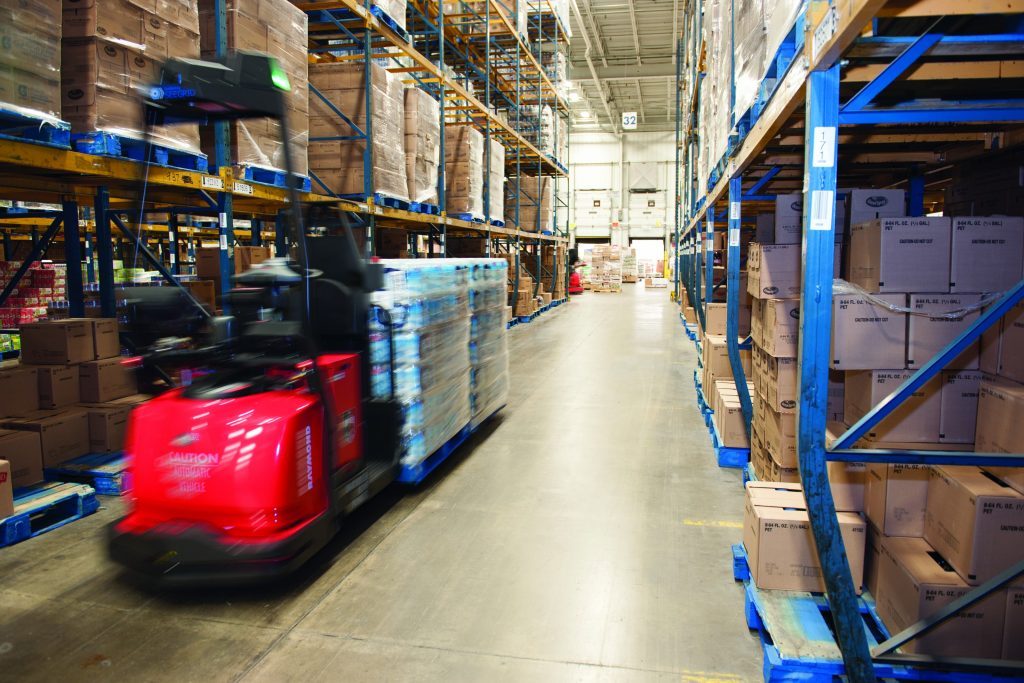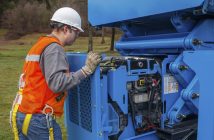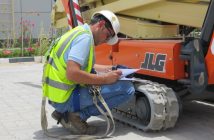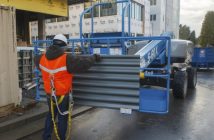Increasing process automation means the cost-effective automation of vehicles is playing an increasingly more important role – which in turn has serious safety implications

Automated guided vehicles (AGVs) are encountered in vast warehouses, order-picking areas and production halls.
Every one of these vehicles must find its way and its exact position in the process – and do so automatically.
For some time now there have been various technologies in this area with specific properties, in testing and also in actual use, and with each further enhancement – for example in sensor technology – new opportunities result.
Today, the diversity of technologies offers numerous versions and performance classes: from systems which follow a wire or tape, through to laser positioning and wireless solutions.
When developing a new idea for an application, all versions are equally available and on the test bench.
A combination between a positioning, navigation and safety solution is frequently striven for. It is worth taking a closer look at and comparing the different technologies, however, since not every technology is suited to every application in equal measure.
For example, small and simple applications commonly have different requirements than larger ones.
As a rule, though, two issues should always be considered together: safety at work and navigation.
In terms of safety at work, safety area scanners may be worth considering, for example, which prevent collisions between vehicles and people or objects.
With regard to navigation, one should investigate whether an additional scanner system or a different technology should be used to navigate the vehicle safely.
With scanners, the data usually comes as bitstream per beam with the angle and distance to the object.
Software with a suitable level of hardware performance is required for evaluating the navigation data of the vehicle.
Safety shutdown
Equally, a shutdown mechanism via the safety function must be considered.
Current developments and performance increases of safety laser scanners will soon permit the output of navigation data via recognized and standardized bus interfaces, thus combining both functions in one device.
This simplifies system integration and significantly reduces installation and interface complexity.
An example of this combined solution is the RSL400 safety laser scanner with PROFINET from Leuze electronic.
The safety laser scanners are also readily used in combination with systems that contain reference positions by means of transponders or code reading.
This is especially the case in areas where there is an overlap of automatic AGVs and manned vehicles for supporting pick assistance systems; in goods receiving, dispatch and in order picking, for example.
In such cases there is a corresponding reader moving along inside the vehicle.
Transponders or codes are arranged on the floor or in the ceiling at crossings and reference positions, which are connected to assistance systems for additional information, amongst other things.
In these applications, too, the vehicles are appropriately equipped to a technically high grade.
Systems which work with reference positions or navigation scanners are usually flexible in terms of changes.
Often there is a change to the new situation merely from the teaching-in or graphical drawing of new reference points.
This flexibility has many advantages, thus justifying its price.
However, in the case of application a critical assessment should be conducted, since this flexibility is not always necessary.
In enclosed areas where there is hardly any human traffic, a simpler type is highly popular: tracking with induction wires or magnetic tape.
In this process the vehicle unwaveringly follows the wire/tape on the floor.
Simple controls
On the vehicle itself only relatively simple control system functionality is required.
This solution is therefore also suited to simple AGVs.
The wire itself is robust and durable, but not flexible because it has to be housed in the floor screed.
Magnetic tape offers somewhat more flexibility.
The floor structure has to be taken into account with this method, however. In numerous warehouses and distribution centers – and also in many production environments, too – soiling no longer poses a real problem, meaning optical systems represent thoroughly decent alternatives.
They are frequently much easier to build or modify.
Optical versions which follow a line are particularly flexible in this performance class, since the line can easily be installed or even modified; especially if it is formed from adhesive tape.
Cameras or sensors are commonly used for the optical detection and tracking of the line.
Depending on the environment, narrow curves and ambient light are more critical for cameras than for sensors.
A new technology based on contrast detection comes in the form of the OGS 600 from Leuze electronic: a new sensor for optical tracking.
This sensor allows for a detection width of 140 to 280 mm on an illuminated adhesive tape with a line and contrasted trace.
With the standard, simple vehicle interfaces, it is suited to use in AGVs of all sizes.
The diversity of AGV applications across a broad variety of industries and sectors shows how frequently the necessity of a large range of technologies and technical options arises.
It is only this way that a solution tailored to the respective application can be achieved at a good price/performance ratio.
This is why a large number of AGV providers and sensor manufacturers offer various technological solutions.
With the OGS 600, Leuze electronic is presenting a new sensor that enables cost-effective vehicle automation for the transport of materials and goods in production and storage areas.
With its edge detection and control signal transmission to the steering motor, the trace can be guided optically, which means that driving can be automated in the simplest of ways.
The routes of the driverless transportation systems can be flexibly adapted.
The compact design of the OGS 600 and its low minimum distance to the ground of 10 mm means it can be integrated even into flat vehicles.
Models with different detection widths and response times cover a wide range of possible applications, even for narrow curves and at high speeds.
Parameterization and interface integration is implemented via the Sensor Studio software.
An assistant analyzes the contrast between the ground and the trace and recommends the ideal trace colour.
A high level of functionality and ambient light protection are provided, much like fast commissioning and easy address adaptation.




